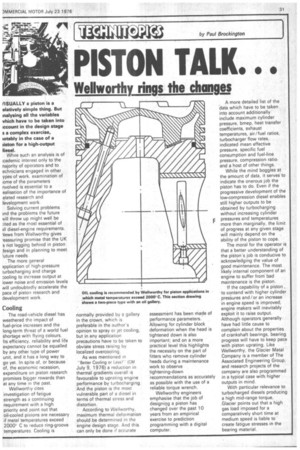IEGHNI OP
Page 33

If you've noticed an error in this article please click here to report it so we can fix it.
by Paul Brockington
PISTON TALK.
Wellworthy rings the changes
fISUALLY a piston is a elatively simple thing. But inalysing all the variables vhich have to be taken into iccount in the design stage s a complex exercise, lotably in the case of a piston for a high-output liesel.
While such an analysis is of ,cademic interest only to the najority of operators and to echnicians engaged in other ypes of work, examination of ome of the parameters nvolved is essential to a ealisation of the importance of elated research and levelopment work.
Solving current problems Ind the problems the future ivill throw up might well be :ited as the most essential of all diesel-engine requirements. 'Jews from Wellworthy gives .eassuring promise that the UK s not lagging behind in piston iesign and in planning to meet 'uture needs
The more general application of high-pressure urbocharging and charge :ooling to increase output at lower noise and emission levels viIl undoubtedly accelerate the pace of piston research and development work,
Cooling
The road-vehicle diesel has weathered the impact of fuel-price increases and the long-term threat of a world fuel shortage with flying colours. Its efficiency, reliability and life expectancy cannot be equalled by any other type of power unit, and it has a long way to go yet. In spite of, or because of, the economic recession, expenditure on piston research promises bigger rewards than at any time in the past.
Wellworthy cites investigation of fatigue strength as a continuing requirement with a high priority and point out that oil-cooled pistons are necessary if metal temperatures exceed 2000 C to reduce ring-groove temperatures. Cooling is normally provided by a gallery in the crown, which is preferable in the author's opinion to spray or jet cooling, but in any application precautions have to be taken to obviate stress raising by localized overcooling.
As was mentioned in "Better Cooling or Less?" (CM July 9, 1976) a reductIon in thermal gradients overall is favourable to uprating engine performance by turbocharging. And the piston is the most vulnerable part of a diesel in terms of thermal stress and distortion.
According to Wellworthy, maximum thermal deformation should be determined in the engine design stage And this can only be done if accurate assessment has been made of performance parameters. Allowing for cylinder block deformation when the head is tightened down is also important; and on a more practical level this highlights the necessity on the part of fitters who remove cylinder heads during a maintenance work to observe tightening-down recommendations as accurately as possible with the use of a reliable torque wrench.
Wellworthy engineers emphasise that the job of designing a, piston has changed over the past 10 years from an empirical exercise to prediction programming with a digital computer. A more detailed list of the data which have to be taken into account additionally include maximum cylinder pressure, bmep, heat transfer coefficients, exhaust temperatures, air/fuel ratios, turbocharger flow rates, indicated mean effective pressure, specific fuel consumption and fuel-line pressure, compression ratio, and a host of other things.
While the mind boggles at the amount of data, it serves to indicate the onerous job the piston has to do. Even if the progressive development of the low-compression diesel enables still higher outputs to be obtained by turbocharging without increasing cylinder pressures and temperatures more than marginally, the limit of progress at any given stage will mainly depend on the ability of the piston to cope.
The moral for the operator is that a better understanding of the piston's job is conducive to acknowledging the value of good maintenance. The most likely internal component of an engine to suffer from bad maintenance is the piston.
If the capability of a piston , to contend with higher cylinder presSures and/or an increase in engine speed is improved, engine makers will inevitably exploit it to raise output. Although operators generally have had little cause to complain about the properties of crankshaft bearings, bearing progress will have to keep pace with piston uprating. Like Wellworthy, the Glacier Metal Company is a member of The Associated Engineering Group, and research projects of the company are also programmed in a typical case with higher outputs in mind.
With particular relevance to turbocharged diesels producing a high mid-range torque, .Glacier points out that a high gas load imposed for a comparatively short time at medium speed is liable to create fatigue stresses in the bearing material,
















































































































